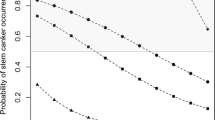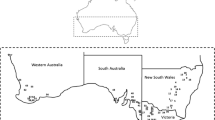Abstract
Phoma stem canker of oilseed rape (Brassica napus), caused by Leptosphaeria maculans/L. biglobosa is a globally important disease. Severe phoma stem canker symptoms have been observed on winter oilseed rape in China but the seed yield loss caused by this disease remains unknown. In May 2012 and May 2013, 17 and 13 crops were surveyed, respectively, in seven counties of Hubei Province, central China. Stems with phoma stem canker disease symptoms were sampled for pathogen isolation and identification. Only L. biglobosa was identified by culture morphology and species-specific PCR; no L. maculans was found. To evaluate the yield losses, yield components (number of branches per plant, number of pods per plant, 1000-seed weight, number of seeds per pod) were assessed on healthy and diseased plants sampled from crops in four counties and on plants from inoculated pot experiments (plants of three cultivars were inoculated at the green bud stage by injecting L. biglobosa conidia into the stem between the first and second leaf scars). Results of the field surveys showed that diseased plants had 14–61% less branches and 32–83% less pods than healthy plants, respectively. The estimated seed yield loss varied from 10% to 21% and from 13% to 37% in 2012 and 2013, respectively. In the pot experiments, there were no differences in numbers of branches or pods but there were differences in number of seeds per pod between inoculated and control plants. For the three cultivars tested, the inoculated plants had yield losses of 29–56% compared with the control. This study indicates that L. biglobosa could cause substantial seed yield loss in China.




Similar content being viewed by others
References
Cai, X., Yang, L., Zhang, J., & Li, G. Q. (2014a). First report of Leptosphaeria biglobosa causing blackleg on Brassica campestris ssp. chinensis var. purpurea in central China. Plant Disease, 98, 1156.
Cai, X., Yang, L., Zhang, J., & Li, G. Q. (2014b). First report of Leptosphaeria biglobosa causing blackleg on Raphanus sativus in central China. Plant Disease, 98, 993.
Dai, F. L. (1979). Flora Fungoru Sinicorum (pp. 1027–1028). Beijing, China: Science Press.
Delourme, R., Chèvre, A. M., Brun, H., Rouxel, T., Balesdent, M. H., Dias, J. S., et al. (2006). Major gene and polygenic resistance to Leptosphaeria maculans in oilseed rape (Brassica napus). European Journal of Plant Pathology, 114, 41–52.
Fitt, B. D. L., Brun, H., Barbetti, M. J., & Rimmer, S. R. (2006a). World-wide importance of phoma stem canker (Leptosphaeria maculans and L. biglobosa) on oilseed rape (Brassica napus). European Journal of Plant Pathology, 114, 3–15.
Fitt, B. D. L., Huang, Y. J., van den Bosch, F., & West, J. S. (2006b). Coexistence of related pathogen species on arable crops in space and time. Annual Review of Phytopathology, 44, 163–182.
Fitt, B. D. L., Hu, B. C., Li, Z. Q., Liu, S. Y., Lange, R. M., Kharbanda, P. D., et al. (2008). Strategies to prevent spread of Leptosphaeria maculans (phoma stem canker) onto oilseed rape crops in China; costs and benefits. Plant Pathology, 57, 652–664.
Gladders, P., & Musa, T. (1979). The development of Leptosphaeria maculans in winter oilseed rape and its implications for disease control. Proceedings of the British Crop Protection Conference-Pests and Diseases, 129–136.
Gugel, R., & Petrie, G. (1992). History, occurrence, impact, and control of blackleg of rapeseed. Canadian Jorunal of Plant Pathology, 14, 36–45.
Huang, Y. J., Toscano-Underwood, C., Fitt, B. D. L., Hu, X. J., & Hall, A. M. (2003). Effects of temperature on ascospore germination and penetration of oilseed rape (Brassica napus) leaves by A- or B-group Leptosphaeria maculans (phoma stem canker). Plant Pathology, 52, 245–255.
Huang, Y. J., Fitt, B. D. L., Jedryczka, M., Dakowska, S., West, J. S., Gladders, P., et al. (2005). Patterns of ascospore release in relation to phoma stem canker epidemiology in England (Leptosphaeria maculans) and Poland (Leptosphaeria biglobosa). European Journal of Plant Pathology, 111, 263–277.
Huang, Y. J., Qi, A. M., King, G. J., & Fitt, B. D. L. (2014). Assessing quantitative resistance against Leptosphaeria maculans (phoma stem canker) in Brassica napus (oilseed rape) in young plants. PloS One, 9, e84924.
Jedryczka, M., Nikonorenkov, V. A., Levitin, M., Gasich, E., Lewartowska, E., & Portenko, L. (2002). Spectrum and severity of fungal diseases on spring oilseed rape in Russia. IOBC WPRS Bulletin, 25, 13–20.
Karolewski, Z., Kosiada, T., Hylak-Nowosad, B., & Nowacka, K. (2002). Changes in population structure of Leptosphaeria maculans in Poland. Phytopathologia Polonia, 25, 27–34.
Lacoste, L., Louvet, J., Anselme, C., Alabouvette, C., Brunin, B., & Pierre, J. (1969). Rôle de Phoma lingam (Tode) Desm. et de sa forme parfaite, Leptosphaeria maculans (Desm.) Ces. et de Not. dans les épidémies de nécrose du collet de colza (Brassica napus L. var. oleifera Metzer). Comptes Rendus de l'Academie d'Agriculture de France, 981–987.
Larkan, N. J., Ma, L., & Borhan, M. H. (2015). The Brassica napus receptor-like protein RLM2 is encoded by a second allele of the LepR3/Rlm2 blackleg resistance locus. Plant Biotechnology Journal, 13, 983–992.
Li, C. X., Wratten, N., Salisbury, P. A., Burton, W. A., Potter, T. D., Walton, G., et al. (2008). Response of Brassica napus and B. juncea germplasm from Australia, China and India to Australian populations of Leptosphaeria maculans. Australasian Plant Pathology, 37, 162–170.
Li, Q. S., Rong, S. B., Hu, B. C., Jiang, Y. F., Hou, S. M., Fei, W. X., et al. (2013). Distribution of blackleg disease on oilseed rape in China and its pathogen identification. Chinese Journal of Oil Crop Sciences, 35, 415–423.
Liu, S. Y., Liu, Z., Fitt, B. D. L., Evans, N., Foster, S. J., Huang, Y. J., et al. (2006). Resistance to Leptosphaeria maculans (phoma stem canker) in Brassica napus (oilseed rape) induced by L. biglobosa and chemical defence activators in field and controlled environments. Plant Pathology, 55, 401–412.
Liu, Z., Latunde-Dada, A., Hall, A., & Fitt, B. D. L. (2014). Phoma stem canker disease on oilseed rape (Brassica napus) in China is caused by Leptosphaeria biglobosa ‘brassicae’. European Journal of Plant Pathology, 140, 841–857.
Marcroft, S. J., Sosnowski, M. R., Scott, E. S., Ramsey, M. D., Salisbury, P. A., & Howlett, B. J. (2005). Brassica napus Plants infected by Leptosphaeria maculans after the third to fifth leaf growth stage in south-eastern Australia do not develop blackleg stem canker. European Journal of Plant Pathology, 112, 289–292.
Möller, E. M., Bahnweg, G., Sandermann, H., & Geige, H. H. (1992). A simple and efficient protocol for isolation of high molecular weight DNA from filamentous fungi, fruit bodies, and infected plant tissues. Nucleic Acids Research, 20, 6115–6116.
Rimmer, R., & Berg, V. D. (2007). Blackleg (phoma stem canker). In S. R. Rimmer, V. I. Shattuck, & L. Buchwaldt (Eds.), Compendium of brassica diseases (pp. 19–22). St Paul, MN, USA: APS Press.
Rong, S. B., Hu, B. C., Chen, F. X., Wu, X. J., Hou, S. M., Fei, W. X., et al. (2015). Effects of Leptosphaeria biglobosa on grain yield and yield related traits of oilseed rape. Crops, 169, 159–161.
Shoemaker, R. A., & Brun, H. (2001). The teleomorph of the weakly aggressive segregate of Leptosphaeria maculans. Canadian Journal of Botany, 79, 412–419.
Song, P. L., Jedryczka, M., Irzykowski, W., Yan, M. J., Huangfu, H. Y., Hao, L. F., et al. (2016). Efficient detection of Leptosphaeria maculans from infected seed lots of oilseed rape. Journal of Phytopathology, 164, 1097–1104.
Toscano-Underwood, C, Huang, Y.J, Fitt, B.D.L., & Hall, A.M. (2003). Effects of temperature on maturation of pseudothecia of Leptosphaeria maculans and L. biglobosa on oilseed rape stem debris. Plant Pathology, 52, 726–736.
Van Der Spek, J. (1981). Blackleg of oilseed rape in Netherlands. Medelelingen van de Faculteit Landbouwwetenschappen Rijksuniversiteit Gent, 46, 813–822.
West, J. S., Evans, N., Liu, S., Hu, B., & Peng, L. (2000). Leptosphaeria maculans causing stem canker of oilseed rape in China. Plant Pathology, 49, 800.
West, J. S., Kharbanda, P. D., Barbetti, M. J., & Fitt, B. D. L. (2001). Epidemiology and management of Leptosphaeria maculans (phoma stem canker) on oilseed rape in Australia, Canada and Europe. Plant Pathology, 50, 10–27.
West, J. S., Balesdent, M. H., Rouxel, T., Narcy, J. P., Huang, Y. J., Roux, J., et al. (2002). Colonization of winter oilseed rape tissues by a/Tox(+) and B/Tox(0) Leptosphaeria maculans (phoma stem canker) in France and England. Plant Pathology, 51, 311–321.
Zhang, X., White, R. P., Demir, E., Jedryczka, M., Lange, R. M., Islam, M., et al. (2014). Leptosphaeria spp., phoma stem canker and potential spread of L. maculans on oilseed rape crops in China. Plant Pathology, 63, 598–612.
Zhou, Y., Fitt, B. D. L., Welham, S. J., Gladders, P., Sansford, C., & West, J. S. (1999). Effects of severity and timing of stem canker (Leptosphaeria maculans) symptoms on yield of winter oilseed rape (Brassica napus) in the UK. European Journal of Plant Pathology, 105, 715–728.
Acknowledgements
We thank the China Agriculture Research System (Grant CARS-13), China National Science and Technology Supporting Program (Grant No. 2010BAD01B04), the UK Biotechnology and Biological Sciences Research Council (BBSRC), AHDB Cereals and Oilseeds and the Felix Thornley Cobbold Agricultural Trust for supporting the work.
Author information
Authors and Affiliations
Corresponding author
Rights and permissions
About this article
Cite this article
Cai, X., Huang, Y., Jiang, D. et al. Evaluation of oilseed rape seed yield losses caused by Leptosphaeria biglobosa in central China. Eur J Plant Pathol 150, 179–190 (2018). https://doi.org/10.1007/s10658-017-1266-x
Accepted:
Published:
Issue Date:
DOI: https://doi.org/10.1007/s10658-017-1266-x




